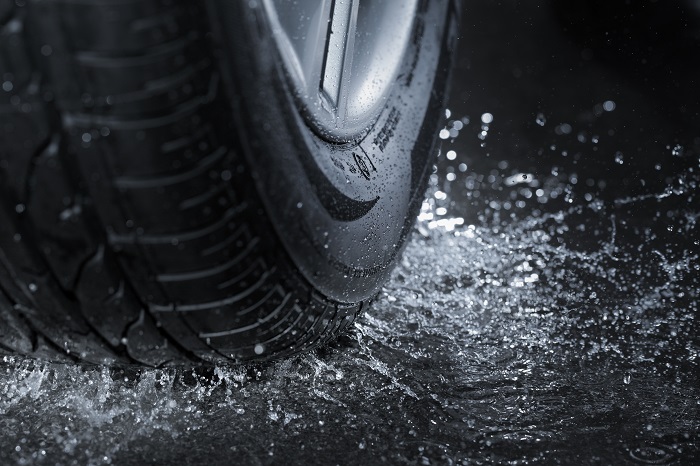
Are you ready for wet, slippery roads?
Every driver thinks that driving in the rain is no big deal.
But in one second, it could become one of the most terrifying experiences of your life.
Remember how much water was on the roads in 2017, after record-breaking rainfall amounts?
When it rains, hydroplaning is a real possibility. It could cause a serious accident – or worse.
What is Hydroplaning?
“It’s something I’ve experienced numerous times, and we cover it in the classroom,” says Tom Wainwright of Young Drivers Canada.
Hydroplaning (or aquaplaning) is when your tires skid or slide on a wet road surface, and you experience a loss of traction.
Normally, your tires push away water on the road to make direct contact with the asphalt.
When there’s too much water, the pressure pushes it under your tires instead.
This creates a layer of water that separates your tires from the road, and causes you to lose your steering, braking, and acceleration.
Here’s a video we find incredibly helpful when it comes to explaining hydroplaning.
What To Do if Your Car Starts Hydroplaning
We know that it’s scary to experience a loss of control over your car, particularly in rain when visibility is reduced. But you actually need to be just as careful when the rain first starts.
“The first 10 minutes of a light rain is the most dangerous time,” Tom says. “Anything over 60 kilometres an hour, and you’ll most likely hydroplane.”
Why is that? “It’s because the rain is mixing with everything on the road: dirt, grit. It’s making it even more slippery. Drivers also haven’t adjusted their driving to the new conditions yet,” Tom explains.
If you do hydroplane, the important thing to remember is: don’t panic.
The next step is to correct the situation.
“You should ease off the gas, and stay as straight as possible,” says Tom. “If you had any intentions of turning, abandon them right away.”
You should also stay far away from the brakes, as it will increase the sliding. “The brake is taboo,” Tom confirms.
Tips for Driving in the Rain in Ottawa
If 2018 is anything like 2017, you’ll spend some time driving in all kinds of rain.
We have some tips to help you prevent hydroplaning, and stay safe during the rainy season.
1. If There’s Water on the Road, Don’t Use Cruise Control
Cruise control is great for long road trips on dry days – not so good for rainy ones.
Your cruise control won’t adjust to road conditions: only you can do that.
When it starts to rain, or if it’s rained earlier in the day, don’t use your cruise control to get around. This will reduce your chances of hydroplaning significantly.
2. Go Slow
Speed is the leading cause of accidents. If you don’t adjust yours accordingly with the road conditions, you could be the next statistic.
Like Tom said, anything over 60 kilometres is risky when rain first starts. We don’t know about you, but we trust the pro.
3. Make Sure Your Tire Tread Isn’t Worn – And That They’re Properly Inflated
You can’t have traction without good quality tires and tread. “It doesn’t matter if they’re winter or all-season tires, but you need to have a good tread. A bald tire won’t grip anything, especially in the rain,” Tom says.
It’s a good idea to have your tires inspected by professionals like us. We’ll give you our honest opinion on their condition – and if they need to be replaced, we have you covered.
Tip: Tires that aren’t properly inflated will increase your chance of hydroplaning. Make sure to check your air pressure regularly, and top up as needed.
4. Avoid the Puddles
Have you heard the saying ‘don’t go looking for trouble’?
That’s what standing water and puddles are on roads: nothing but trouble.
They could be potholes, low spots in the road, or backed up from nearby drains. The problem is you have no idea until it’s too late.
“You should adjust your course if you see puddles or standing water on the road,” says Tom. But remember: no dangerous swerving.
5. Brake Gently
The last thing you should do when the roads are slick is slam on the brakes.
When driving in heavy rains, you should always gently ease on the brakes in a gradual motion. Give yourself plenty of time to come to a full, safe stop.
Tom’s Tip: Remember that the brake is taboo when you’re hydroplaning.
6. Follow the Leader At a Safe Distance
One of the best ways to avoid hydroplaning is follow the tire tracks in front of you.
The cars in front of you will have already dispersed most of the water. When you drive in their tracks, you’ll get more traction.
Just remember to leave a safe distance between yourself and anyone in front of you.
7. Focus 100% on Driving
Multitasking is a great skill: just not for driving.
When you’re behind the wheel, you need to focus 100% on being a safe, responsible driver. Here are some tips to help end distracted driving habits >
Have Your Tires and Your Car Checked Before Ottawa’s Rainy Season
Before Ottawa’s rainy season kicks into gear, come to Bemac to have your tires changed and rotated. We want to put you on the road with the right tires for the season.
Now is also a great time to have your oil changed and your engine checked. The last thing you need is for something to go wrong when you’re driving in heavy rain.
Then, when the forecast calls for rain, you can say: “bring it on.”









